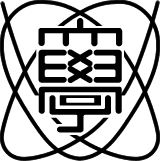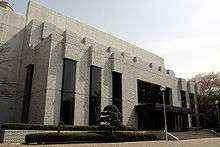University of Electro-Communications
| 電気通信大学 | |
 | |
| Type | National |
|---|---|
| Established |
1945 - The Central Technical Institute for Wireless-Communications 1918 - The Technical Institute for Wireless-Communications |
| President | Takashi Fukuda[1] |
Administrative staff | 250 |
| Undergraduates | 3800 |
| Postgraduates | 1500 |
| Location | Chōfu, Tokyo, Japan |
| Campus | Urban |
| Colors | (DIC-256) |
| Website | www.uec.ac.jp |

The University of Electro-Communications (電気通信大学 Denki-Tsūshin Daigaku) is a national university in the city of Chōfu, Tokyo, Japan. It specialises in the disciplines of computer science, the physical sciences, engineering and technology. It was founded in 1918 as the Technical Institute for Wireless-Communications .
History
The University of Electro-communications was originally founded in the Azabu district, Tokyo city as the Technical Institute for Wireless-Communications by Wireless Association in 1918. The Technical Institute for Wireless-Communications was transferred to the Ministry of Communications in 1942 and renamed to the Central Technical Institute for Wireless-Communications in 1945. Following to the transfer from the Ministry of Communications to the Ministry of Education in 1948, the University of Electro-communications was established as a national university in 1949. The campus was moved to the city of Chōfu, Tokyo in 1957. The university has been run by the National University Corporation since 2004.
School symbol
The school symbol has a long history . The student union picked up the topic and discussed it with the University in the year when it obtained university status (1949). Based on the approval from the faculty council in September 1949, a prize competition was held targeting at students and employees. As a result, the design of a Lissajous figure of the frequency ratio of 5 to 6 with Chinese characters meaning "University", submitted by Professor Sadao Matsumura (who later became the fourth President, serving from 3 October 1967 to 28 February 1969), won the competition, and the prize money of 2,000 yen (amount at that time) was given to him. The frequency ratio of 5 to 6 corresponds to the commercial power frequencies of 50 Hz in eastern Japan and 60 Hz in western Japan, and was selected for its meaning of Japan-wide harmonisation. Therefore, the Lissajous figure university symbol can be said to represent the ethos of foundation of the University, that is "to establish a university which is open to all over Japan, by call it by a name without any geographical name, the University of ElectroCommunications".
Organisation
Faculties
- Faculty of Electro-Communications (until 2010)
- Information and Communication Engineering
- Computer Science
- Electronic Engineering
- Applied Physics and Chemistry
- Mechanical Engineering and Intelligent Systems
- Systems Engineering
- Human Communications
- Faculty of Informatics and Engineering (since 2010)
- Informatics
- Communication Engineering and Informatics
- Mechanical Engineering and Intelligent Systems
- Engineering Science
- Fundamental Programs for Advanced Engineering
Graduate schools
- Graduate School of Electro-Communications (Until 2010)
- Information and Communication Engineering
- Computer Science
- Electronic Engineering
- Applied Physics and Chemistry
- Mechanical Engineering and Intelligent Systems
- Systems Engineering
- Human Communication
- Graduate School of Informatics and Engineering (Since 2010)
- Informatics
- Communication Engineering and Informatics
- Mechanical Engineering and Intelligent Systems
- Engineering Science
- Graduate School of Information Systems
- Human Media Systems
- Social Intelligence and Informatics
- Information Network Systems
- Information on System Fundamentals
Centers for Education and Research
- Institute for Laser Science
- Advanced Wireless Communication Research Center(AWCC)
- Center for Space Science and Radio Engineering (SSRE)
- Center for Frontier Science and Engineering
- Center for Photonic Innovation
- Research Center for Ubiquitous Networking and Computing
- Advanced Ultrafast Laser Research Center
- Innovation Research Center for Fuel Cells
Notable faculty
- Kwan-ichi Terazawa - mathematician and member of the Japan Academy
- Hideo Seki - radio engineer and recipient of the National Medal of Japan with Purple Ribbon and the Order of the Sacred Treasure
- Takehiro Sueki - philosopher and recipient of the Order of the Rising Sun (1997)
- Noriaki Kano - consultant in quality management, recipient of the Deming Prize (1997), and also known for Kano model
- Shigemi Sasaki - mechanical engineer and recipient of the Order of the Sacred Treasure (2009)
- Masahiro Mori - roboticist
- Hiroshi Takuma - physicist, OSA Fellow Emeritus, IEEE Life Fellow, and recipient of the National Medal of Japan with Purple Ribbon (1995) and the Order of the Rising Sun (2001)
- Kanji Nishio - German literary figure and philosopher
- Te Sun Han - information theorist and recipient of the Shannon Award (2010)
- Hisaki Matsuura - poet and novelist
Notable alumni
Businesspersons
- Takuro Bojo, B.E. in 1959 - former CEO of JVC
- Tetsuya Nakamura, B.E. in 1967 - CEO of SMK Corporation
- Ken Kutaragi, B.E. in Electronic Engineering in 1975 - former CEO of Sony Computer Entertainment, current Honorary Chairman of Sony Corporation, and also known as Father of PlayStation
- Keiichiro Tsukamoto - founder of ASCII Corporation and Impress Group
- Seiji Nishikawa, B.E. in 1978 - operating officer of NTT docomo
- Kōichi Nakamura - video game designer and founder of Chunsoft
Scholars and Researchers
- Eikichi Yamashita, B.S. in 1956 - electrical engineer, IEEE Life Fellow, and recipient of the University of Illinois Distinguished Alumni Award (2000)
- Sumio Iijima, B.E. in 1963 - discoverer of carbon nanotubes and recipient of the Benjamin Franklin Medal (2002) and the Balzan Prize (2007)
- Prayoon Shiowattana - Vice President of Thailand National Science and Technology Development Agency
- Seinosuke Toda, B.E. in 1982, M.E. in 1984 - computer scientist, recipient of the Gödel Prize (1998), and also known for Toda's theorem
- Maria Q. Feng, Ph.D. in 1987 in Mechanical Engineering - recipient of the Alfred Noble Prize (1995), and Professor at Columbia University
Others
- Ken Amano - politician and former Governor of Yamanashi Prefecture
- Noritoshi Ishida - politician and member of New Komeito Party
- Jiro Nitta - novelist
- Soichi Terada - composer and musician
References
External links
- The University of Electro-Communications
- The University of Electro-Communications (in English)
- UEC Library
- UEC Campus map
Coordinates: 35°39′21″N 139°32′39″E / 35.65583°N 139.54417°E